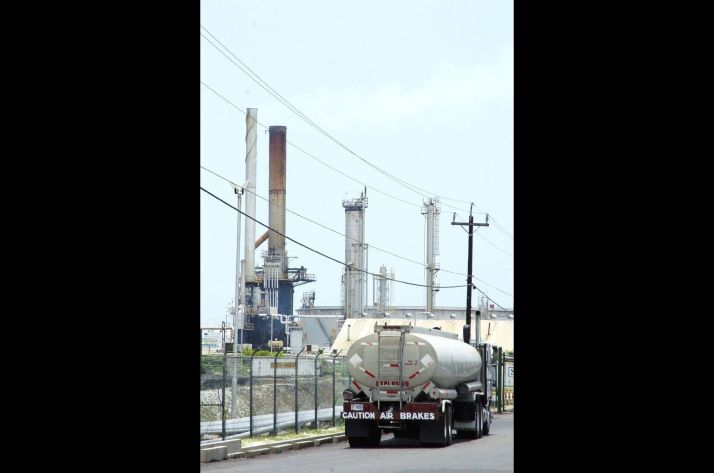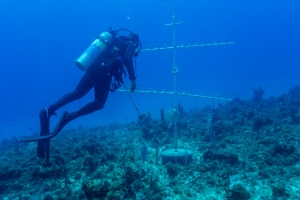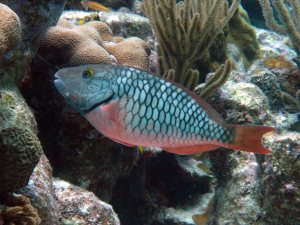The original article appears in UWI Pelican Magazine
Cannabis also called Solomon’s Weed, Ganja or Marijuana, is hailed as God’s gift to medicine but only a handful of institutions including UWI’s Mona Campus are studying the properties and possible medicinal applications
By Zadie Neufville
The University of the West Indies has revived the ganja research programme it began in the 1970s as it prepares to launch Jamaica as a global “powerhouse” for cannabis research; as famous for its products and services as it already is for reggae and the good ‘ol sensi weed’.
UWI’s Mona Campus in Kingston is one of the few places in the world where marijuana research can take place from plant breeding, through to clinical trials. The country’s international reputation – the ganja culture, music and athletic success – has brought many to the UWI in search of research collaborations.
There is new energy and excitement as researchers leverage over four decades of experience in cannabis research, even as they await the completion of regulations that will guide recent amendments to the Dangerous Drug Act.
“We have the knowledge and we have the expertise to make Jamaica and the Mona Campus a major centre, the leading authority and we are positioned to use our Jamaica brand to drive the programme,” Principal of the UWI’s Mona Campus Professor Archibald McDonald, said in an interview with the Pelican.
Best known for the euphoric effect of THC (tetrahydrocannabinol), Cannabis is said to contain more than 60 other chemical compounds. It is these other elements that the UWI and its partners want to exploit in its mission to treat a host of complaints for which modern medicines have no answer.
Researchers are particularly excited by the possibilities of the cannabinoids (CBDs), a group of chemicals referred to as terpenophenolic compounds, also known as terpins.
Scientists at UWI’s research partner Citiva Medical are also excited by the promise of ‘terpens’, particularly after the team successfully developed cannabis-derived products to treat a number of ailments. Citiva is the company behind Charlotte’s Web – a strain of cannabis with less than 0.3 % THC – which is being used to treat paediatric epilepsy.
Prior to being treated with the cannabis extract, 8-year-old Charlotte Figi reportedly suffered up to 300 seizures a day due to a rare form of epilepsy, even while on traditional medicines. The extract from Charlotte’s Web and continued success of the treatments using the oil is one of several success stories from Citiva.
The strain of cannabis named Charlotte’s Web for the little American girl, is being grown at the UWI and will be studied with a view to standardising the extracts. The aim is to ensure that every cannabis plant used for medicine has exactly “the same levels of the specific chemical compounds” required to target specific illnesses, with the same results.
In the medicinal cannabis world, Citiva’s executive director Josh Stanley is a rock star. Described as ‘telegenic’ in his approach to the marketing of cannabis as the future of medicine, both Stanley and the equally visionary McDonald share the belief that research in cannabis goes way beyond smoking the weed.
“We are interested in the whole plant, getting away from the single compound and into the promise of its biology – a multi-compound approach to its natural properties,” Stanley said.

Professor Archibald McDonald, Principal – UWI Mona
McDonald noted: “We are using our permit effectively to help us to establish a Centre of excellence in cannabis research in the Caribbean. We want the Mona Campus to become the leader in Cannabis research internationally”.
And there is no shortage of researchers willing to help him build UWI’s reputation and join the quest to find treatment for a long list of complaints. In addition to examining the use of cannabis in the treatment of diabetes, epilepsy, cancer and chronic pain, the UWI Medicinal Cannabis Research Group (UWI-MCRG) is also contemplating the possibilities for its use in anaesthesia and psychiatry among other areas.
Since 2010 UWI’s Forensic Unit under the leadership of Professor Wayne McLaughlin has diligently mapped the DNA of cannabis to among other things, help police identify key ganja growing areas on the island. These days, the data is being repurposed and put to more beneficial uses, he said.
McLaughlin noted that chemical and gene profiling have allowed researchers to classify cannabis plants not only by the names the farmers give them, but also by the plants’ colouring, their unique chemical compositions as well as by the genes that will make them less susceptible to contamination from heavy metals and other impurities.
“Now we are not only able to track the plants but also look at other genes that are important to the plant and its survival. We can now identify those plants with high and low THC and CBD levels as well as identify male and female plants,” the forensic scientist said.
The UWI-MC Research Group are light years ahead of the authorities and were ready with scores of project ideas covering all areas of medicine and science by the time the University received its exemption permit last year.
“The lobby (for legalisation) had the widest cross section of people and professions I’ve ever seen,” Professor McDonald laughed. The result, he explained, is that the UWI is already working on scores of projects ranging from basic science studies to pre-clinical and clinical studies, all in an effort to expand knowledge of the therapeutic uses of cannabis.

Marijuana researchers on the Caribbean island of Jamaica are planning to develop new pharmaceutical products following the partial decriminalisation of cannabis. (AP/David McFadden)
At the same time, the medicinal research is being enhanced by the ongoing chemical and DNA analyses of the plant. McLaughlin agreed that with so much of the gene sequencing and identification of the chemicals already done, the work done by his team has slashed several years from the expected start-up of clinical trials. It also makes possible the start of the planned Pain Clinic by year’s end, just about coinciding with the start of clinical trials at the University Hospital of the West Indies.
The United States medical marijuana industry is expected to earn as much as US 13billion dollars by 2019 up from US 2.7 billion dollars in 2014. It is expected that the UWI and indeed Jamaica can earn a significant share of the global market from pharmaceuticals, bringing jobs and much needed development. But there will be no products to smoke at the UWI’s Medical Research facilities, even with the 100 million US dollars in monthly sales the US State of Colorado reportedly makes from medical marijuana.
“We aim to change their perception that Jamaica is about a bunch of Rastas and white women getting high,” researcher Carole Lindsay said chuckling. She has been leading the chemical analysis of every strain of Cannabis the University collects from farmers.
A professional chemist, Lindsay noted that creating the chemical profiles of the plants found in Jamaica is critical to protecting both the country’s and the University’s interests.
“Our local strains of cannabis are vulnerable because we assume that with all the interest in ganja, people could be bringing in plants to grow them here. We also know that farmers have been doing their own cross breeding for years,” she explained.

Ganja plants being destroyed by security forces.
Aside from ongoing research into the properties and effects of Cannabis, the UWI was among the first in the world to successfully develop medicines from the plant. Its work, going back to 1972 when ophthalmologist Albert Lockhart and pharmacologist Dr. Manley West began investigating the anecdotes of fishermen who attributed their exceptional night-vision to their consumption of ‘ganja teas’.
From their research, the Department of Pharmacology in 1987 released the Canasol (TM), eye drops to treat glaucoma and followed that success in later years by a number of pioneering marijuana-derived pharmaceuticals: Asmasol for asthma; Cantivert also used to treat glaucoma; Canavert for motion sickness and Cansens for treating viral infections.
“They (the products) were sold on the local market but we really never managed to export it because of the cannabis. But what it showed clearly, was that there are substances in ganja which can provide effective treatment of glaucoma and asthma,” McDonald, a surgeon by training said.
Much of the University’s work in Cannabis is unknown internationally because the laws that prohibited the use of marijuana severely hampered the University’s research programme as well as the marketing of the products.
In Jamaica, the ‘weed’ is also listed as a dangerous drug and until April 2016, possession attracted penalties of imprisonment. The 1961 UN Convention on Narcotic Drugs criminalised the possession of ganja, a plant that had been used for generations as traditional medicine by local healers and householders.
When parliament ratified the amendment to the Dangerous Drug Act on April 15, it revived decades old research ambitions at UWI and other local institutions. It also paved the way for a “broad permit” that facilitated the planting of the first legal cannabis plant, thereby establishing UWI’s own ‘ganja’ plot and officially initiating the production and testing of cannabis derived medicines.

Rastafarians can freely use ‘ganja’ as a sacrament
The amendment that was inked on 6 February – birthdate of the late reggae icon Bob Marley – relaxed rules on the use of ganja on the island. Nowadays, possession of two ounces (56 grams) or less, no longer results in jail time. Rastafarians can freely use ‘ganja’ as a sacrament for the first time since the birth of their movement in the 1930s and householders are allowed to grow up to five plants.
In the months since, several companies have released a number of nutraceuticals and topical pain products derived from cannabis. Not withstanding, McDonald said, UWI is interested in the whole plant.
“Our interest is in unraveling the science behind ganja,” he said.
It’s a philosophy shared by its major partners including Citiva Medical, which Stanley a co-founder said, includes the belief “that the future of cannabinoid medicine lies in strict adherence to unraveling the science”.
As head of the UWI Cannabis Research Group, McDonald is expecting even more successes with new technologies, new investments, new partners and if negotiations go well, he is also looking forward to creating improved versions of Canasol and Asmasol.

Strains of Charlotte’s Web grow in the facility at UWI as Citiva and the University unravel the secrets to producing consistent dosages of the chemicals found. Photo Z. Neufville
US Federal legislation classification of cannabis the plant as a class 1 drug has forced the Jamaican government to tread lightly, even as it granted permits to UWI and others. Regardless, the University is accelerating its research, construction of green houses, the cultivation of several species of cannabis and the signing of MOUs with agencies and organisations from across the globe.
There are several proposals awaiting the regulations and profiling must be done quickly to continue supporting the research and development. To aid the process, more than 600,000 US dollars have been spent to upgrade the equipment in the Toxicology lab.
“We are expecting that many products will be produced and have to be tested and quality checked for them to be marketed. We also expect the USDA will soon come up with regulations on cannabis-derived medicines and we are preparing to meet them,” Lindsay said.
Construction of the UWI Mona Cannabis Research Centre and supporting facilities to expand the institutions research capacity and house its partners is estimated to cost some US 4million dollars.
McDonald is expecting that funding from partners will equip and build the facility as “their contribution to UWI’s 40-year cannabis research legacy, accommodation and the prestige of brand-Jamaica”.




















